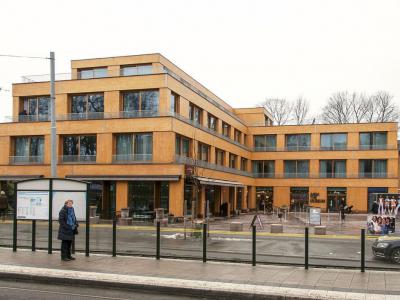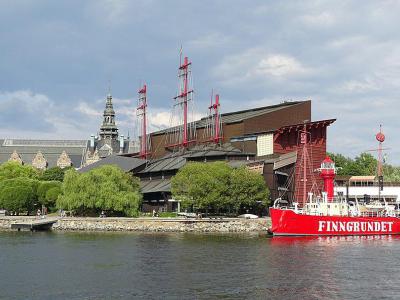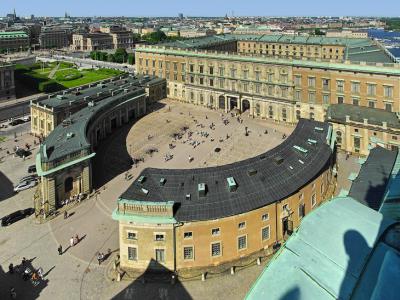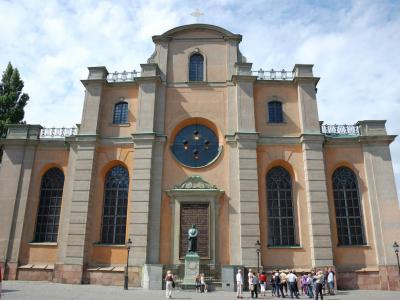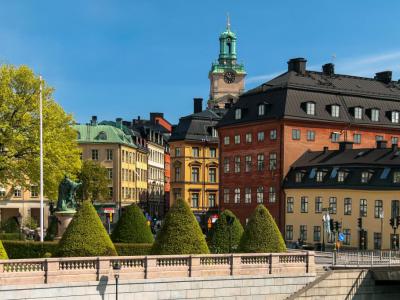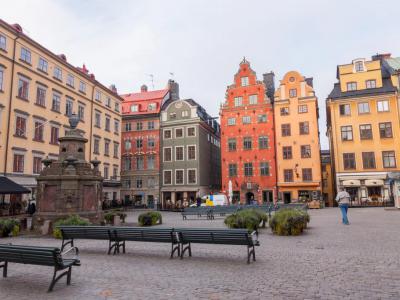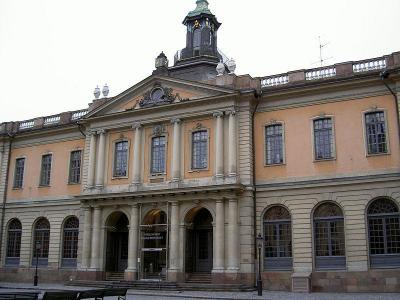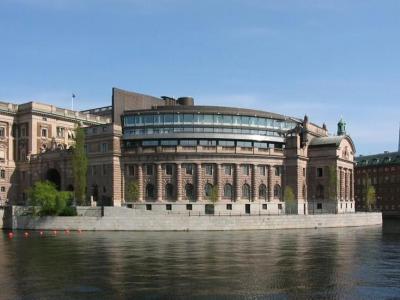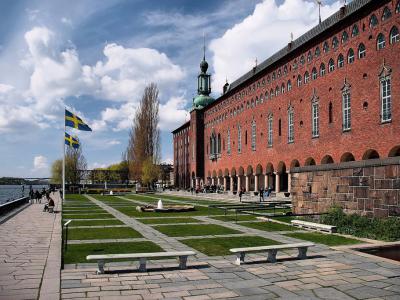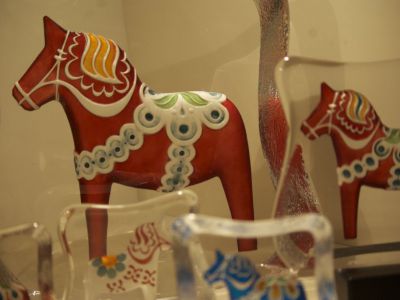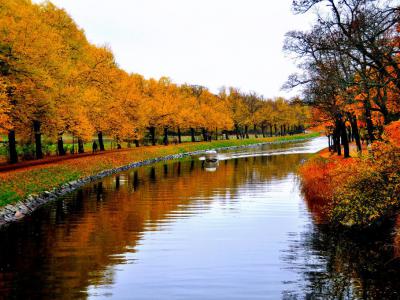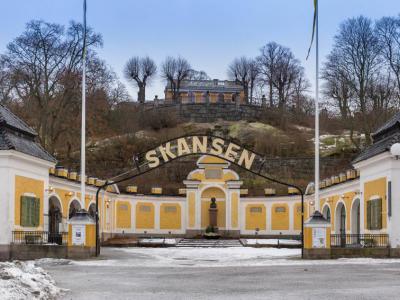Custom Walk in Stockholm, Sweden by lynchsonia69_9c897 created on 2025-03-12
Guide Location: Sweden » Stockholm
Guide Type: Custom Walk
# of Sights: 12
Tour Duration: 5 Hour(s)
Travel Distance: 12.8 Km or 8 Miles
Share Key: T64SE
Guide Type: Custom Walk
# of Sights: 12
Tour Duration: 5 Hour(s)
Travel Distance: 12.8 Km or 8 Miles
Share Key: T64SE
How It Works
Please retrieve this walk in the GPSmyCity app. Once done, the app will guide you from one tour stop to the next as if you had a personal tour guide. If you created the walk on this website or come to the page via a link, please follow the instructions below to retrieve the walk in the app.
Retrieve This Walk in App
Step 1. Download the app "GPSmyCity: Walks in 1K+ Cities" on Apple App Store or Google Play Store.
Step 2. In the GPSmyCity app, download(or launch) the guide "Stockholm Map and Walking Tours".
Step 3. Tap the menu button located at upper right corner of the "Walks" screen and select "Retrieve custom walk". Enter the share key: T64SE
1) ABBA: The Museum (must see)
ABBA: The Museum in Stockholm is an immersive and interactive exhibition dedicated to the iconic pop band ABBA. Opened in May 2013, the museum is located on the picturesque island of Djurgården, a short walk or ride from Stockholm's city center.
The idea for a museum dedicated to ABBA was inspired by the success of The Beatles museum in Liverpool, England, and was first proposed in 2006. Although the initial plan faced several delays and financial challenges, resulting in the project being temporarily abandoned in 2009, new plans were unveiled in 2012. These plans culminated in the opening of ABBA: The Museum, which now serves as the permanent home for the ABBAWORLD exhibit that toured Europe and Australia from 2009 to 2011.
The museum offers a comprehensive look at ABBA's legacy, showcasing the band's iconic stage costumes, artifacts, concert footage, and interviews in a contemporary and interactive setting. Visitors can engage with several interactive audio and video stations, where they can perform ABBA's music, sing along with holograms of the band, and even try on digital versions of famous costumes, like Anni-Frid's 'tiger' tunic or Agnetha's 'cat' tunic.
ABBA: The Museum provides a unique experience for fans and newcomers alike, offering a deep dive into the history and impact of ABBA's music and cultural influence. The museum has the full support of the band members, with much of the material on display coming from their private collections. Whether you’re reliving the glamour of the 1970s or discovering the phenomenon for the first time, the museum offers a fascinating insight into ABBA's enduring legacy as a global superstars.
Tip:
Buy your tickets in advance for a discount and get there early or later in the day (2-3 hrs before closing).
On all the interactive exhibits that require singing, you should sing loudly and directly into the microphone.
Please keep your tickets as you'll need to scan your barcode so you can download your performances/quiz results later from their website.
The idea for a museum dedicated to ABBA was inspired by the success of The Beatles museum in Liverpool, England, and was first proposed in 2006. Although the initial plan faced several delays and financial challenges, resulting in the project being temporarily abandoned in 2009, new plans were unveiled in 2012. These plans culminated in the opening of ABBA: The Museum, which now serves as the permanent home for the ABBAWORLD exhibit that toured Europe and Australia from 2009 to 2011.
The museum offers a comprehensive look at ABBA's legacy, showcasing the band's iconic stage costumes, artifacts, concert footage, and interviews in a contemporary and interactive setting. Visitors can engage with several interactive audio and video stations, where they can perform ABBA's music, sing along with holograms of the band, and even try on digital versions of famous costumes, like Anni-Frid's 'tiger' tunic or Agnetha's 'cat' tunic.
ABBA: The Museum provides a unique experience for fans and newcomers alike, offering a deep dive into the history and impact of ABBA's music and cultural influence. The museum has the full support of the band members, with much of the material on display coming from their private collections. Whether you’re reliving the glamour of the 1970s or discovering the phenomenon for the first time, the museum offers a fascinating insight into ABBA's enduring legacy as a global superstars.
Tip:
Buy your tickets in advance for a discount and get there early or later in the day (2-3 hrs before closing).
On all the interactive exhibits that require singing, you should sing loudly and directly into the microphone.
Please keep your tickets as you'll need to scan your barcode so you can download your performances/quiz results later from their website.
2) Vasa Museum (must see)
The Vasa Museum is a unique maritime museum experience; in fact, it is said to be the most popular museum in all of Scandinavia. It houses a 17th-century 64-gun warship that has been meticulously restored and preserved. It is a grand lady of the sea, measuring 69 meters and was built under the rule of King Gustavus Adolphus of Sweden. Intended to be the flagship of the Swedish Navy, the ship sunk on its maiden voyage, barely making it out of the harbor, when high seas and wind overtook its deck.
Vasa is filled with some of the most ornate and exquisite carvings ever seen on a ship of its kind. It is located in a climate and humidity controlled environment and is constantly monitored and maintained to keep it in the most ideal condition for a relic of its age. The ship is a terrific photographic subject but expect its interior to be dark, making it difficult to get that perfect photo. Besides the ship itself, the museum is filled with tools of the maritime trade and traces the history of Scandinavian maritime society.
Why You Should Visit:
It's not much of a stretch to say that there are not many ships available to examine that were built in 1628. Inside, there are several levels so you can see it from all angles.
As a bonus, at the back of the building, you can visit three interesting boats belonging to the Maritime Museum – and for free!
Tip:
Allow a couple of hours for the visit and therefore arrive 2/3 hours before it closes – it will be much quieter then.
Vasa is filled with some of the most ornate and exquisite carvings ever seen on a ship of its kind. It is located in a climate and humidity controlled environment and is constantly monitored and maintained to keep it in the most ideal condition for a relic of its age. The ship is a terrific photographic subject but expect its interior to be dark, making it difficult to get that perfect photo. Besides the ship itself, the museum is filled with tools of the maritime trade and traces the history of Scandinavian maritime society.
Why You Should Visit:
It's not much of a stretch to say that there are not many ships available to examine that were built in 1628. Inside, there are several levels so you can see it from all angles.
As a bonus, at the back of the building, you can visit three interesting boats belonging to the Maritime Museum – and for free!
Tip:
Allow a couple of hours for the visit and therefore arrive 2/3 hours before it closes – it will be much quieter then.
3) Royal Palace (must see)
The Royal Palace in Stockholm, also known as Stockholm Palace, is the official residence of the Swedish monarch, although King Carl XVI Gustaf and Queen Silvia primarily reside at Drottningholm Palace. Situated in the Old Town of Stockholm (Gamla Stan), adjacent to the Parliament building, the Royal Palace is a significant ceremonial venue for the King in his role as head of state.
This historic site has served as a royal residence since the mid-13th century, originally home to the Three Crowns (Tre Kronor) Castle. Following a devastating fire in 1697, the current palace was constructed, with its completion delayed until 1754 due to the Great Northern War. The palace is one of the largest in the world, boasting over 1,400 rooms, including state and guest apartments, the Hall of State, the Royal Chapel, and several museums.
Visitors are welcomed by the Swedish Royal Guard, a tradition rooted in medieval Sweden, adding to the palace's majestic atmosphere. The palace’s interior is notable for its exquisite copper roof and houses significant cultural artifacts, including the Bernadotte Library, the Royal Armoury, and the Three Crowns Museum.
One of the most distinguished features is Gustav III's Museum of Antiquities, one of Europe’s oldest museums, which displays over 200 sculptures acquired by King Gustav III during his travels in Italy. The palace also offers a unique shopping experience at the Royal Gift Shop, where visitors can purchase exclusive items linked to the Royal Collections. The shop is open daily with free entry, making it a popular destination for both history enthusiasts and those seeking distinctive souvenirs.
Tip:
While the rooms are well-marked in English, it's always good to go on a guided tour for a more personalized experience.
The Treasury room, with all the regalia, would justify taking the tour as you get to learn more about what you're looking at.
This historic site has served as a royal residence since the mid-13th century, originally home to the Three Crowns (Tre Kronor) Castle. Following a devastating fire in 1697, the current palace was constructed, with its completion delayed until 1754 due to the Great Northern War. The palace is one of the largest in the world, boasting over 1,400 rooms, including state and guest apartments, the Hall of State, the Royal Chapel, and several museums.
Visitors are welcomed by the Swedish Royal Guard, a tradition rooted in medieval Sweden, adding to the palace's majestic atmosphere. The palace’s interior is notable for its exquisite copper roof and houses significant cultural artifacts, including the Bernadotte Library, the Royal Armoury, and the Three Crowns Museum.
One of the most distinguished features is Gustav III's Museum of Antiquities, one of Europe’s oldest museums, which displays over 200 sculptures acquired by King Gustav III during his travels in Italy. The palace also offers a unique shopping experience at the Royal Gift Shop, where visitors can purchase exclusive items linked to the Royal Collections. The shop is open daily with free entry, making it a popular destination for both history enthusiasts and those seeking distinctive souvenirs.
Tip:
While the rooms are well-marked in English, it's always good to go on a guided tour for a more personalized experience.
The Treasury room, with all the regalia, would justify taking the tour as you get to learn more about what you're looking at.
4) Stockholm Cathedral (must see)
Stockholm Cathedral, also known as the Church of Saint Nicholas (Sankt Nikolai Kyrka), is the oldest and one of the most historically significant temples in Stockholm. Centrally located at the highest point of Old Town (Gamla Stan), it is flanked by the Stock Exchange Building and Stockholm Palace, forming an integral part of the city's Baroque architectural landscape.
The cathedral was consecrated in 1306, with its origins dating back to the 13th century. It features a late medieval hall interior, while the exterior showcases Baroque modifications added in the 18th century. As a crucial site during the Reformation, Stockholm Cathedral hosted the first Mass in the Swedish language. Since 1942, it has served as the seat of the Bishop of Stockholm, highlighting its ongoing religious importance.
The cathedral has a deep historical connection with the Swedish royal family, having served as the city's sole parish church for many centuries. It has been the venue for royal coronations and other significant ceremonies, including the wedding of Crown Princess Victoria in 2010. The cathedral continues to play a vital role in national events and memorials, such as the funeral of renowned Swedish author Astrid Lindgren.
Inside, the cathedral houses several significant artworks, including a medieval sculpture of Saint George and the Dragon and the Vädersolstavlan painting, one of the earliest depictions of Stockholm. The surrounding area of the cathedral is rich with historical courtyards and statues, including representations of Reason, Divine Love, Caution, and Hope. Additionally, a statue of Olaus Petri, a key figure in the Swedish Reformation, stands near the church's east facade, where the pavement also marks the former extent of a church choir demolished during the reign of King Gustav Vasa in the 16th century.
Why You Should Visit:
Architecturally interesting, culturally enriching, and very peaceful.
Tip:
Check for free organ recitals (usually at noon) and other events.
Make sure to pick up a brochure as it is very helpful in explaining several main focuses within the cathedral.
The cathedral was consecrated in 1306, with its origins dating back to the 13th century. It features a late medieval hall interior, while the exterior showcases Baroque modifications added in the 18th century. As a crucial site during the Reformation, Stockholm Cathedral hosted the first Mass in the Swedish language. Since 1942, it has served as the seat of the Bishop of Stockholm, highlighting its ongoing religious importance.
The cathedral has a deep historical connection with the Swedish royal family, having served as the city's sole parish church for many centuries. It has been the venue for royal coronations and other significant ceremonies, including the wedding of Crown Princess Victoria in 2010. The cathedral continues to play a vital role in national events and memorials, such as the funeral of renowned Swedish author Astrid Lindgren.
Inside, the cathedral houses several significant artworks, including a medieval sculpture of Saint George and the Dragon and the Vädersolstavlan painting, one of the earliest depictions of Stockholm. The surrounding area of the cathedral is rich with historical courtyards and statues, including representations of Reason, Divine Love, Caution, and Hope. Additionally, a statue of Olaus Petri, a key figure in the Swedish Reformation, stands near the church's east facade, where the pavement also marks the former extent of a church choir demolished during the reign of King Gustav Vasa in the 16th century.
Why You Should Visit:
Architecturally interesting, culturally enriching, and very peaceful.
Tip:
Check for free organ recitals (usually at noon) and other events.
Make sure to pick up a brochure as it is very helpful in explaining several main focuses within the cathedral.
5) Gamla Stan (Old Town) (must see)
The Old Town (Gamla Stan) is the historic heart of Stockholm. Officially known until 1980 as "the Town between the Bridges," this area is situated primarily on the island of Stadsholmen. Although the name Gamla Stan is colloquially used to refer to the entire Old Town, it also officially includes the surrounding islets of Riddarholmen, Helgeandsholmen, and Strömsborg. The area is home to approximately 3,000 residents.
Dating back to the 13th century, Old Town is a well-preserved medieval district, characterized by its narrow alleyways, cobblestone streets, and historical architecture. The influence of North German architectural styles is particularly evident in many of the buildings. The area has been shaped by some of Sweden’s most notable architects, such as Nicodemus Tessin and Carl Hårleman, who played key roles in the construction of significant landmarks like the Stockholm Palace.
Old Town is rich in historical buildings, including the Stockholm Stock Exchange Building, Bonde Palace (the seat of the Swedish Supreme Court), and the House of Nobility, which once hosted the Swedish parliament. In the heart of Old Town lies Stortorget, a picturesque large square surrounded by old merchants' houses and notable buildings such as the Stockholm Stock Exchange Building. Stortorget is also infamous as the site of the Stockholm Bloodbath of 1520, where Danish King Christian II ordered the execution of Swedish noblemen, leading to a revolt that eventually dissolved the Kalmar Union and saw the rise of King Gustav I.
Key landmarks in Old Town include the Stockholm Cathedral, the Nobel Museum, and the Riddarholm Church, which is the royal burial church. Another significant site is the Royal Palace, which was constructed in the 18th century after the previous palace, Tre Kronor, was destroyed by fire. The House of Nobility (Riddarhuset), located in the north-western part of Old Town, is another historic structure of note.
Old Town is also home to one of the world's oldest continuously operating restaurants, Den Gyldene Freden, located on Österlånggatan. Established in 1722, it has maintained its original environment and is now owned by the Swedish Nobel Academy, which holds weekly luncheons there. The Stockholm Cathedral houses the famous statue of Saint George and the Dragon, sculpted by Bernt Notke, while the Riddarholm Church (Riddarholmskyrkan) serves as the royal burial church.
Tip:
Some streets can be a bit too touristy to handle, so try and stay away from the beaten tracks and explore a bit, or come in the morning for a stroll.
If you look beyond the tourist shops, there are quite a few nice little fascinating stores.
Dating back to the 13th century, Old Town is a well-preserved medieval district, characterized by its narrow alleyways, cobblestone streets, and historical architecture. The influence of North German architectural styles is particularly evident in many of the buildings. The area has been shaped by some of Sweden’s most notable architects, such as Nicodemus Tessin and Carl Hårleman, who played key roles in the construction of significant landmarks like the Stockholm Palace.
Old Town is rich in historical buildings, including the Stockholm Stock Exchange Building, Bonde Palace (the seat of the Swedish Supreme Court), and the House of Nobility, which once hosted the Swedish parliament. In the heart of Old Town lies Stortorget, a picturesque large square surrounded by old merchants' houses and notable buildings such as the Stockholm Stock Exchange Building. Stortorget is also infamous as the site of the Stockholm Bloodbath of 1520, where Danish King Christian II ordered the execution of Swedish noblemen, leading to a revolt that eventually dissolved the Kalmar Union and saw the rise of King Gustav I.
Key landmarks in Old Town include the Stockholm Cathedral, the Nobel Museum, and the Riddarholm Church, which is the royal burial church. Another significant site is the Royal Palace, which was constructed in the 18th century after the previous palace, Tre Kronor, was destroyed by fire. The House of Nobility (Riddarhuset), located in the north-western part of Old Town, is another historic structure of note.
Old Town is also home to one of the world's oldest continuously operating restaurants, Den Gyldene Freden, located on Österlånggatan. Established in 1722, it has maintained its original environment and is now owned by the Swedish Nobel Academy, which holds weekly luncheons there. The Stockholm Cathedral houses the famous statue of Saint George and the Dragon, sculpted by Bernt Notke, while the Riddarholm Church (Riddarholmskyrkan) serves as the royal burial church.
Tip:
Some streets can be a bit too touristy to handle, so try and stay away from the beaten tracks and explore a bit, or come in the morning for a stroll.
If you look beyond the tourist shops, there are quite a few nice little fascinating stores.
6) Stortorget (Grand Square) (must see)
Contrary to its name, Stockholm's "Grand Square" (Stortorget) was never a stylish showpiece unlike the ones in many other European cities during the Middle Ages. It was created gradually, with the surrounding buildings added haphazardly throughout the years.
Nowadays, this is the city's oldest square and an artistic and shopping hub, particularly renowned for its annual Christmas market with fun shows, traditional handicrafts, and sumptuous culinary delights.
It is also the location of the Stock Exchange Building (Börshuset) – home to the Swedish Academy, the Nobel Museum, and the Nobel Library – built in 1773 through 1776. The nearby well dried up in 1856 due to land elevation. It was then relocated to another square (Brunkebergstorg) but eventually moved back to its original location in the 1950s, and has been connected to the city water conduit ever since.
Grand Square sits at the highest point in Stockholm and presents a carefully restored rendition of the historical buildings. Among them is house No. 3 constructed in the 1640s, commonly known as Grill House (Grillska Huset), named after its owner, Antoni Grill. The nearby building No. 5 was also Grill's property. The buildings at numbers 18 and 20 were merged into one in the 17th century and named for Johan Eberhard Schantz, the secretary of King Charles X Gustavus. House No. 22, on the left side of the square, once occupied by one of the closest friends of King Charles XI, was built in 1758 and is easily identified by its green color.
The square had a violent history, ill-famed as the location of the Stockholm Bloodbath, which took place in 1520 and resulted in the beheadings of over 80 noblemen. Their bodies were left there to bleed out, leaving pools of blood running throughout the town. Eww...(((
Indeed, the antique cobblestones of Grand Square make you feel like stepping back into the times of Old Sweden, with the pastel buildings mimicking the colors commonplace in those days.
Why You Should Visit:
The Old Town is by far the most picturesque area in Stockholm, and while this square seems unpretentious at first sight, it has a unique ambiance.
Tip:
Make sure to stand in the middle and look all around you.
Nowadays, this is the city's oldest square and an artistic and shopping hub, particularly renowned for its annual Christmas market with fun shows, traditional handicrafts, and sumptuous culinary delights.
It is also the location of the Stock Exchange Building (Börshuset) – home to the Swedish Academy, the Nobel Museum, and the Nobel Library – built in 1773 through 1776. The nearby well dried up in 1856 due to land elevation. It was then relocated to another square (Brunkebergstorg) but eventually moved back to its original location in the 1950s, and has been connected to the city water conduit ever since.
Grand Square sits at the highest point in Stockholm and presents a carefully restored rendition of the historical buildings. Among them is house No. 3 constructed in the 1640s, commonly known as Grill House (Grillska Huset), named after its owner, Antoni Grill. The nearby building No. 5 was also Grill's property. The buildings at numbers 18 and 20 were merged into one in the 17th century and named for Johan Eberhard Schantz, the secretary of King Charles X Gustavus. House No. 22, on the left side of the square, once occupied by one of the closest friends of King Charles XI, was built in 1758 and is easily identified by its green color.
The square had a violent history, ill-famed as the location of the Stockholm Bloodbath, which took place in 1520 and resulted in the beheadings of over 80 noblemen. Their bodies were left there to bleed out, leaving pools of blood running throughout the town. Eww...(((
Indeed, the antique cobblestones of Grand Square make you feel like stepping back into the times of Old Sweden, with the pastel buildings mimicking the colors commonplace in those days.
Why You Should Visit:
The Old Town is by far the most picturesque area in Stockholm, and while this square seems unpretentious at first sight, it has a unique ambiance.
Tip:
Make sure to stand in the middle and look all around you.
7) Nobel Prize Museum (must see)
The Nobel Prize Museum in Stockholm is a must-visit destination for anyone interested in the legacy of Alfred Nobel, the Nobel Prize, and its distinguished laureates. Opened in 2001 to commemorate the centenary of the Nobel Prize, the museum offers an immersive experience into the world of this prestigious award.
The museum’s permanent exhibition showcases a fascinating collection of artifacts, personal stories, and historical accounts from Nobel Prize winners dating back to 1901. Visitors can learn about the lives and contributions of iconic figures such as Marie Curie, Nelson Mandela, and Winston Churchill.
One of the museum's highlights is the "Cultures of Creativity Exhibit," which guides visitors through the intricate process of selecting a Nobel Prize winner, culminating in the grandeur of the Nobel Banquet. An integral part of this experience is the Nobel ice cream, a treat traditionally served at the annual awards ceremony, which visitors can sample during their visit.
The museum offers daily multilingual tours, including in English, and hosts a variety of public events, conferences, and workshops. These activities are designed to engage and educate visitors, making the museum a dynamic hub of learning and inspiration.
For those wishing to take home a unique souvenir, the museum's shop offers a range of exclusive items, such as dark fair-trade chocolate versions of Alfred Nobel's gold medal and Swedish “dynamite” candy flavored with jalapeño pepper. The shop also features educational toys, books by and about Nobel laureates, and other distinctive keepsakes.
Visitors can also enjoy a meal at Bistro Nobel, which serves a selection of Swedish cakes, Nobel chocolate, and the famous Nobel ice cream and tea-both of which are featured at the Nobel Banquet. The bistro provides a perfect spot to relax and reflect on the museum's inspiring exhibits while enjoying traditional Swedish cuisine.
Tip:
Join the English tour to get the most out of your visit.
The museum’s permanent exhibition showcases a fascinating collection of artifacts, personal stories, and historical accounts from Nobel Prize winners dating back to 1901. Visitors can learn about the lives and contributions of iconic figures such as Marie Curie, Nelson Mandela, and Winston Churchill.
One of the museum's highlights is the "Cultures of Creativity Exhibit," which guides visitors through the intricate process of selecting a Nobel Prize winner, culminating in the grandeur of the Nobel Banquet. An integral part of this experience is the Nobel ice cream, a treat traditionally served at the annual awards ceremony, which visitors can sample during their visit.
The museum offers daily multilingual tours, including in English, and hosts a variety of public events, conferences, and workshops. These activities are designed to engage and educate visitors, making the museum a dynamic hub of learning and inspiration.
For those wishing to take home a unique souvenir, the museum's shop offers a range of exclusive items, such as dark fair-trade chocolate versions of Alfred Nobel's gold medal and Swedish “dynamite” candy flavored with jalapeño pepper. The shop also features educational toys, books by and about Nobel laureates, and other distinctive keepsakes.
Visitors can also enjoy a meal at Bistro Nobel, which serves a selection of Swedish cakes, Nobel chocolate, and the famous Nobel ice cream and tea-both of which are featured at the Nobel Banquet. The bistro provides a perfect spot to relax and reflect on the museum's inspiring exhibits while enjoying traditional Swedish cuisine.
Tip:
Join the English tour to get the most out of your visit.
8) Riksdag (Parliament House)
The Parliament House is the seat of the Swedish Parliament (Riksdag) and is situated on Helgeandsholmen, an islet in the heart of Stockholm's historic district, Gamla stan. This iconic building complex was designed by architect Aron Johansson in a style that combines Neoclassical architecture with a Baroque Revival facade, reflecting the grandeur and historic significance of the Swedish legislative body.
Construction of the Parliament House began in 1897 and finished in 1905 after Johansson won a design competition in 1889. The new complex replaced the Old Riksdag Building on Riddarholmen and initially included two main buildings: one for the Riksdag and one for the Swedish National Bank. The bank building, semicircular in shape, was later converted to house the new Assembly Hall when the Riksdag became unicameral in 1971. During this transition, the bank was relocated, and Parliament temporarily moved to the newly built Kulturhuset in central Stockholm.
Helgeandsholmen, the islet where the Riksdag buildings are located, has a rich history dating back to the 14th century when it was home to a sanctuary that cared for the sick and elderly. Today, the Parliament House is connected by a network of underground passages, some of which pass through areas of significant archaeological interest, including remnants of Stockholm's old city wall from the 16th century.
Despite undergoing various renovations and changes over the years, particularly in the East Wing, the Parliament House has retained much of its original architectural splendor. The building’s interiors feature Art Nouveau elements, contributing to its unique and historic atmosphere. The Parliament House stands as a symbol of Sweden's democratic traditions and serves as a central landmark in Stockholm's architectural and political landscape.
Construction of the Parliament House began in 1897 and finished in 1905 after Johansson won a design competition in 1889. The new complex replaced the Old Riksdag Building on Riddarholmen and initially included two main buildings: one for the Riksdag and one for the Swedish National Bank. The bank building, semicircular in shape, was later converted to house the new Assembly Hall when the Riksdag became unicameral in 1971. During this transition, the bank was relocated, and Parliament temporarily moved to the newly built Kulturhuset in central Stockholm.
Helgeandsholmen, the islet where the Riksdag buildings are located, has a rich history dating back to the 14th century when it was home to a sanctuary that cared for the sick and elderly. Today, the Parliament House is connected by a network of underground passages, some of which pass through areas of significant archaeological interest, including remnants of Stockholm's old city wall from the 16th century.
Despite undergoing various renovations and changes over the years, particularly in the East Wing, the Parliament House has retained much of its original architectural splendor. The building’s interiors feature Art Nouveau elements, contributing to its unique and historic atmosphere. The Parliament House stands as a symbol of Sweden's democratic traditions and serves as a central landmark in Stockholm's architectural and political landscape.
9) Stadshuset (City Hall) (must see)
Stockholm City Hall (Stadshuset) serves as the seat of the Stockholm Municipality and stands as one of the city's most iconic landmarks. Located on the eastern tip of Kungsholmen island, it overlooks Riddarfjärden and faces the islands of Riddarholmen and Södermalm, creating a picturesque backdrop that integrates the city's architectural heritage with its natural waterways.
The building is renowned for its striking National Romantic style, characterized by a blend of robust Northern European brick construction with elements reminiscent of Venetian Gothic architecture. Designed by architect Ragnar Östberg, the City Hall was the result of an architectural competition initiated in 1907, with construction taking place between 1911 and 1923.
A prominent feature of the building is its monumental tower, rising 106 meters and crowned with the Three Crowns, a symbol of Sweden. Visitors can access the tower by elevator or by climbing a 365-step staircase. At the base of the tower is a gold-plated cenotaph dedicated to Birger Jarl, a 13th-century Swedish statesman.
The interior of Stockholm City Hall is equally impressive, with its Blue Hall and Golden Hall serving as major highlights. The Blue Hall, despite its name, lacks blue decorations; instead, it features a grand organ with 10,270 pipes, the largest in Scandinavia, and is the venue for the annual Nobel Prize banquet. The Golden Hall, located above the Blue Hall, is adorned with magnificent mosaics made of over 18 million tiles, depicting scenes from Swedish history and created by the German firm Puhl & Wagner.
Surrounding the City Hall is a small park that features several notable sculptures, including works by Carl Eldh, such as the ensemble representing artists August Strindberg, Gustaf Fröding, and Ernst Josephson. Another striking sculpture is the pillar topped with a statue of Engelbrekt Engelbrektsson, a 15th-century Swedish rebel leader, facing Riddarholmen.
Why You Should Visit:
Imposing from the outside but once inside, with the free guided tour that runs every 30 minutes, the building reveals its treasures.
The wall art is interesting and well-preserved; courtyards are attractive and the gardens provide great views across the water.
Tip:
From May to September, for a small fee, you can climb the tower (or take the lift up if needed) where you have a wonderful 360-degree view of Stockholm.
If you're short on time and want to both take the tour and climb the tower, make sure you visit the website and make note of the time slots (entry only at scheduled times).
The building is renowned for its striking National Romantic style, characterized by a blend of robust Northern European brick construction with elements reminiscent of Venetian Gothic architecture. Designed by architect Ragnar Östberg, the City Hall was the result of an architectural competition initiated in 1907, with construction taking place between 1911 and 1923.
A prominent feature of the building is its monumental tower, rising 106 meters and crowned with the Three Crowns, a symbol of Sweden. Visitors can access the tower by elevator or by climbing a 365-step staircase. At the base of the tower is a gold-plated cenotaph dedicated to Birger Jarl, a 13th-century Swedish statesman.
The interior of Stockholm City Hall is equally impressive, with its Blue Hall and Golden Hall serving as major highlights. The Blue Hall, despite its name, lacks blue decorations; instead, it features a grand organ with 10,270 pipes, the largest in Scandinavia, and is the venue for the annual Nobel Prize banquet. The Golden Hall, located above the Blue Hall, is adorned with magnificent mosaics made of over 18 million tiles, depicting scenes from Swedish history and created by the German firm Puhl & Wagner.
Surrounding the City Hall is a small park that features several notable sculptures, including works by Carl Eldh, such as the ensemble representing artists August Strindberg, Gustaf Fröding, and Ernst Josephson. Another striking sculpture is the pillar topped with a statue of Engelbrekt Engelbrektsson, a 15th-century Swedish rebel leader, facing Riddarholmen.
Why You Should Visit:
Imposing from the outside but once inside, with the free guided tour that runs every 30 minutes, the building reveals its treasures.
The wall art is interesting and well-preserved; courtyards are attractive and the gardens provide great views across the water.
Tip:
From May to September, for a small fee, you can climb the tower (or take the lift up if needed) where you have a wonderful 360-degree view of Stockholm.
If you're short on time and want to both take the tour and climb the tower, make sure you visit the website and make note of the time slots (entry only at scheduled times).
10) Nordic Museum Gift Shop
What to buy here: Dalecarlian horse - perhaps the most well known red horse in the world.
Perhaps the most well known of all swedish artifacts, the Dalecarlian horse with its brick red color and hand painted pattern has become somewhat of a swedish trademark. The original shape is a horse carved in wood, but nowadays the famous horse come in other shapes, in crystal, ceramics or glass. The traditional and original 'Dala Horse' will always be the hand made wooden one, carved and hand painted locally in the swedish county of 'Dalarna'.
The Dalecarlian, or 'Dala Horse' is cut out of wood and hand painted in the traditional folklore or kurbits pattern that is typical for the swedish county of Dalarna, located in the middle of the country. The original and genuine horses are only made in one specific village, Nusnäs, and the original color is brick red. Other colors such as white or blue are approved, but less traditional, even as the oldest horses were not colored at all, as they were pre-dating the production of the brick-red color of the paint.
Perhaps the most well known of all swedish artifacts, the Dalecarlian horse with its brick red color and hand painted pattern has become somewhat of a swedish trademark. The original shape is a horse carved in wood, but nowadays the famous horse come in other shapes, in crystal, ceramics or glass. The traditional and original 'Dala Horse' will always be the hand made wooden one, carved and hand painted locally in the swedish county of 'Dalarna'.
The Dalecarlian, or 'Dala Horse' is cut out of wood and hand painted in the traditional folklore or kurbits pattern that is typical for the swedish county of Dalarna, located in the middle of the country. The original and genuine horses are only made in one specific village, Nusnäs, and the original color is brick red. Other colors such as white or blue are approved, but less traditional, even as the oldest horses were not colored at all, as they were pre-dating the production of the brick-red color of the paint.
Image Courtesy of Miranda Holmqvist.
11) Kungliga Djurgarden (Royal Djurgården) (must see)
Royal Djurgården (Kungliga Djurgården), commonly referred to as Djurgården, is an island and district in Stockholm, forming part of the Royal National City Park. Historically known as Valdemar Island (Valdemarsön), Djurgården is renowned for its rich natural environment, featuring extensive parklands dotted with ancient oak trees, many of which have significant historical and cultural value.
The island is home to several urban settlements, with Djurgårdsstaden and Beckholmen located in its southwestern region. However, much of Djurgården is covered in park areas, which include a variety of museums, culturally significant villas, embassies, and other institutions. Notable landmarks include the open-air museum Skansen and the amusement park Gröna Lund, both of which attract numerous visitors annually. Djurgården has been historically associated with high-profile residents, including royalty, diplomats, and other prominent figures.
Djurgården is renowned for its oak trees, initially intended for Swedish Navy shipbuilding. Although many were slated for felling in the early 19th century, many were preserved, and new ones were planted by Israel af Ström in 1830. By the 1920s, botanist Rutger Sernander cataloged the most impressive oaks, some over 400 years old with circumferences of at least five meters. Despite a decline, Djurgården still has the largest stand of old oaks in Northern Europe.
Among the notable oaks is Prince Eugen's oak, located in the park north of Prince Eugen's Waldemarsudde, which is considered the largest living oak on the island. This majestic tree stands 21 meters tall with a trunk circumference of 920 centimeters and is estimated to be between 300 and 400 years old, with some sources suggesting it could be as old as 1,000 years.
Due to its historical and cultural significance, Southern Djurgården has been designated as a national interest for cultural environment conservation, further underscoring its importance as a treasured part of Sweden's heritage.
The island is home to several urban settlements, with Djurgårdsstaden and Beckholmen located in its southwestern region. However, much of Djurgården is covered in park areas, which include a variety of museums, culturally significant villas, embassies, and other institutions. Notable landmarks include the open-air museum Skansen and the amusement park Gröna Lund, both of which attract numerous visitors annually. Djurgården has been historically associated with high-profile residents, including royalty, diplomats, and other prominent figures.
Djurgården is renowned for its oak trees, initially intended for Swedish Navy shipbuilding. Although many were slated for felling in the early 19th century, many were preserved, and new ones were planted by Israel af Ström in 1830. By the 1920s, botanist Rutger Sernander cataloged the most impressive oaks, some over 400 years old with circumferences of at least five meters. Despite a decline, Djurgården still has the largest stand of old oaks in Northern Europe.
Among the notable oaks is Prince Eugen's oak, located in the park north of Prince Eugen's Waldemarsudde, which is considered the largest living oak on the island. This majestic tree stands 21 meters tall with a trunk circumference of 920 centimeters and is estimated to be between 300 and 400 years old, with some sources suggesting it could be as old as 1,000 years.
Due to its historical and cultural significance, Southern Djurgården has been designated as a national interest for cultural environment conservation, further underscoring its importance as a treasured part of Sweden's heritage.
12) Skansen (must see)
This incredibly impressive museum was the first of its kind in 1891. The open-air museum was created to celebrate Swedish culture and its traditions. The brainchild of Artur Hazelius, the founder of the Nordic Museum, Hazelius acquired land and a collection of buildings over time, which has now come to be known as Skansen. Today, this living museum paints over 300,000 square meters of the Scandinavian landscape.
The museum consists of gardens, fantastic architectural pieces, walking paths and a zoo which houses a variety of animals. Hazelius sought architectural structures which told the story of Scandinavian society. He purchased over 150 buildings throughout the country and moved them to Skansen for display. The buildings represent everything from affluent society to provincial living.
Guests to Skansen can expect to spend many hours exploring the features of the museum or visiting during one of its many celebrations and festivals. Discover the crafts, which were common to Swedish society, by observing traditionally clad craftsmen or explore the zoo, which is filled with animals native to Sweden's ecosystem.
Why You Should Visit:
If you're looking to get a 'sense' of Sweden outside the confines of great halls, Skansen is the place!
Friendly docents will explain really interesting things about the time period or the structure you're visiting.
Plenty of food/drink outlets to keep you refreshed as you explore the 300,000 square meters site, or you can bring a picnic.
Tip:
A must is the Skansen Aquarium and the "monkey house" with everything from funny baboons to scary crocs.
On different Holidays, there are some very exciting traditional celebrations that take place there.
The museum consists of gardens, fantastic architectural pieces, walking paths and a zoo which houses a variety of animals. Hazelius sought architectural structures which told the story of Scandinavian society. He purchased over 150 buildings throughout the country and moved them to Skansen for display. The buildings represent everything from affluent society to provincial living.
Guests to Skansen can expect to spend many hours exploring the features of the museum or visiting during one of its many celebrations and festivals. Discover the crafts, which were common to Swedish society, by observing traditionally clad craftsmen or explore the zoo, which is filled with animals native to Sweden's ecosystem.
Why You Should Visit:
If you're looking to get a 'sense' of Sweden outside the confines of great halls, Skansen is the place!
Friendly docents will explain really interesting things about the time period or the structure you're visiting.
Plenty of food/drink outlets to keep you refreshed as you explore the 300,000 square meters site, or you can bring a picnic.
Tip:
A must is the Skansen Aquarium and the "monkey house" with everything from funny baboons to scary crocs.
On different Holidays, there are some very exciting traditional celebrations that take place there.
